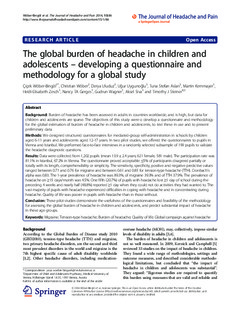| dc.contributor.author | Wober-Bingol, C. | |
| dc.contributor.author | Wöber, c | |
| dc.contributor.author | Uluduz, D | |
| dc.contributor.author | Uygunoğlu, U | |
| dc.contributor.author | Aslan, TS | |
| dc.contributor.author | Kernmayer, M | |
| dc.contributor.author | Zesch, HE | |
| dc.contributor.author | Gerges, NT | |
| dc.contributor.author | Wagner, G | |
| dc.contributor.author | Siva, A | |
| dc.contributor.author | Steiner, Timothy J. | |
| dc.date.accessioned | 2019-11-05T08:59:22Z | |
| dc.date.available | 2019-11-05T08:59:22Z | |
| dc.date.created | 2014-12-26T17:19:33Z | |
| dc.date.issued | 2014 | |
| dc.identifier.issn | 1129-2369 | |
| dc.identifier.uri | http://hdl.handle.net/11250/2626510 | |
| dc.description.abstract | Background
Burden of headache has been assessed in adults in countries worldwide, and is high, but data for children and adolescents are sparse. The objectives of this study were o develop a questionnaire and methodology for the global estimation of burden of headache in children and adolescents, to test these in use and to present preliminary data.
Methods
We designed structured questionnaires for mediated-group self-administration in schools by children aged 6-11 years and adolescents aged 12-17 years. In two pilot studies, we offered the questionnaires to pupils in Vienna and Istanbul. We performed face-to-face interviews in a randomly selected subsample of 199 pupils to validate the headache diagnostic questions.
Results
Data were collected from 1,202 pupils (mean 13.9 ± 2.4 years; 621 female, 581 male). The participation rate was 81.1% in Istanbul, 67.2% in Vienna. The questionnaire proved acceptable: ≤5% of participants disagreed partially or totally with its length, comprehensibility or simplicity. The sensitivity, specificity, positive and negative predictive values ranged between 0.71 and 0.76 for migraine and between 0.61 and 0.85 for tension-type headache (TTH). Cronbach’s alpha was 0.83. The 1-year prevalence of headache was 89.3%, of migraine 39.3% and of TTH 37.9%. The prevalence of headache on ≥15 days/month was 4.5%. One fifth (20.7%) of pupils with headache lost ≥1 day of school during the preceding 4 weeks and nearly half (48.8%) reported ≥1 day when they could not do activities they had wanted to. The vast majority of pupils with headache experienced difficulties in coping with headache and in concentrating during headache. Quality of life was poorer in pupils with headache than in those without.
Conclusion
These pilot studies demonstrate the usefulness of the questionnaires and feasibility of the methodology for assessing the global burden of headache in children and adolescents, and predict substantial impact of headache in these age groups. | nb_NO |
| dc.language.iso | eng | nb_NO |
| dc.publisher | BMC (part of Springer Nature) | nb_NO |
| dc.rights | Navngivelse 4.0 Internasjonal | * |
| dc.rights.uri | http://creativecommons.org/licenses/by/4.0/deed.no | * |
| dc.title | The global burden of headache in children and adolescents - developing a questionnaire and methodology for a global study | nb_NO |
| dc.type | Journal article | nb_NO |
| dc.type | Peer reviewed | nb_NO |
| dc.description.version | publishedVersion | nb_NO |
| dc.source.volume | 15 | nb_NO |
| dc.source.journal | The Journal of Headache and Pain | nb_NO |
| dc.source.issue | 1 | nb_NO |
| dc.identifier.doi | 10.1186/1129-2377-15-86 | |
| dc.identifier.cristin | 1188707 | |
| dc.description.localcode | © 2014 Wöber-Bingöl et al.; licensee Springer. This is an Open Access article distributed under the terms of the Creative Commons Attribution License (http://creativecommons.org/licenses/by/4.0), which permits unrestricted use, distribution, and reproduction in any medium, provided the original work is properly credited. | nb_NO |
| cristin.unitcode | 194,65,30,0 | |
| cristin.unitname | Institutt for nevromedisin og bevegelsesvitenskap | |
| cristin.ispublished | true | |
| cristin.fulltext | original | |
| cristin.qualitycode | 1 | |

